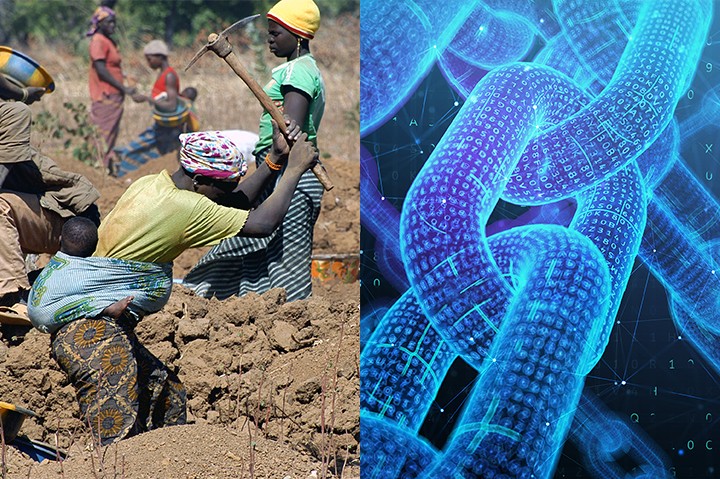How Can Blockchain Improve Sustainability in Mining?
Companies interested in sustainability and transparency are starting to use blockchain to trace materials back to their sources.
Mining plays a key role in the transition to a low-carbon future. Technologies required for this shift, such as wind turbines or solar panels, need vast amounts of mineral and metal inputs.
However, this increased demand can put pressure on the countries where the minerals and metals are extracted, and can lead to violence, conflict and human rights abuses. For example, the extraction of cobalt in the Democratic Republic of Congo (DRC), which produces over 63 per cent of the world’s supply, has been connected to violence so often that cobalt has been nicknamed “the blood diamonds of this decade.”
How can mining ensure sustainability within the cobalt sector as production demands increase?
Ford, one of the world’s best-known car makers, hopes blockchain will be the answer. They will pilot the first blockchain project tracing cobalt supplies from the DRC, with the goal of ensuring manufacturers’ cobalt is not linked to human rights abuses.

What is blockchain?
Distributed ledger technology (DLT) is used to store and exchange assets and information between two parties anywhere in the world in a secure, transparent way.
Blockchain is one type of DLT; it is “a time-stamped series of immutable record of data, managed by a cluster of computers not owned by a single entity.” Blockchain digitally sends information from a starting point to an end point in an automated, safe manner with negligible transaction costs.
In other words, data uploaded onto the blockchain is impossible to change without the consensus of the network.
How can blockchain be used in mining?
Ford’s pilot project provides a real-world example.
In partnership with Huayou Cobalt, IBM, LG Chem and RCS Global, the project uses the IBM Blockchain Platform to create a simulated sourcing scenario. This means the cobalt is produced in the DRC at Huayou’s mining operation and will be tracked as it travels from the mine to be smelted at the LG Chem plant in South Korea, at which point it will be sent to a Ford plant in the United States to be used in cars.
Blockchain will track the cobalt at each stage of this supply chain, from when it is mined to when it is smelted to when it appears in cars.
How will blockchain impact sustainability efforts?
Blockchain can increase transparency in artisanal and small-scale mining operations, contributing raw materials by providing miners the ability to partner with due diligence data providers. This is meant to eliminate the use of cobalt sourced from operations linked to human rights abuses.
More generally, blockchain can be a pivotal tool in sustainable mining supply chains due to its ability to track the financial, environmental, social and regulatory criteria of a project from the moment an operation begins to when an end user has the product in hand.

What challenges do we need to bear in mind?
The inherent challenge of these systems is how to ensure that the data uploaded is correct and reflects the truth. This challenge of how the off-chain and on-chain worlds can be linked is called the “oracle problem.” Blockchain oracles can be trusted organizations that verify the validity of the information before it goes onto the blockchain. In the case of the Ford cobalt pilot, RCS Global could have this role.
There is also the question of whether to use public (permissionless) or private (permissioned) blockchains for supply chain management. While the major permissionless blockchains are more secure because they are more decentralized, the information stored on them is public. This can cause privacy issues for companies who do not want to share all their supply chain information with competitors, regulators or their clients. Therefore, it is not surprising that most supply chain pilots are based on private, permissioned blockchains.
This leads to the final challenge: scalability. Supply chains are moving billions of transactions and large amounts of data, often in real time. The Achilles’ heel for blockchain is its inherent difficulty to scale well. There is always a trade-off between decentralization, network performance and security. So the question remains whether a blockchain-based solution could indeed service the needs of the mining industry while maintaining the benefits of the technology.
Blockchain developers are exploring various solutions to address the issue of scalability. These include the creation of sidechains and looking into ways to break up blockchains into different partitions. It remains to be seen which solution will see more adoption and whether it will be sufficient to address the scaling problems of this emerging technology. We look forward to following Ford’s pilot project and other blockchain applications in supply chain management.
You might also be interested in
Leveraging Digital Infrastructure for Mining Community Resilience
This report explores the socio-economic impacts and potential of new technologies in the mining sector.
IGF Case Study: Decarbonization of the Mining Sector
Case studies from Chile, Indonesia, and South Africa that delve into the role of the mining sector in efforts to reduce greenhouse gas (GHG) emissions.
Modernizing Artisanal and Small-Scale Mining
How will emerging technologies affect the artisanal and small-scale mining sector?
Financial Benefit-Sharing Issues for Critical Minerals: Challenges and opportunities for producing countries
Exploring nuances in the key features of critical minerals and the new challenges and opportunities they present to fiscal regulation.
